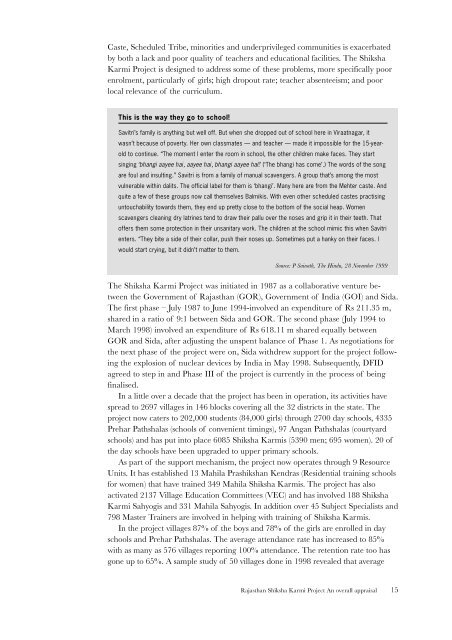Rajasthan Shiksha Karmi Project An overall appraisal
Rajasthan Shiksha Karmi Project An overall appraisal
Rajasthan Shiksha Karmi Project An overall appraisal
You also want an ePaper? Increase the reach of your titles
YUMPU automatically turns print PDFs into web optimized ePapers that Google loves.
Caste, Scheduled Tribe, minorities and underprivileged communities is exacerbatedby both a lack and poor quality of teachers and educational facilities. The <strong>Shiksha</strong><strong>Karmi</strong> <strong>Project</strong> is designed to address some of these problems, more specifically poorenrolment, particularly of girls; high dropout rate; teacher absenteeism; and poorlocal relevance of the curriculum.This is the way they go to school!Savitri’s family is anything but well off. But when she dropped out of school here in Viraatnagar, itwasn’t because of poverty. Her own classmates — and teacher — made it impossible for the 15-yearoldto continue. “The moment I enter the room in school, the other children make faces. They startsinging ‘bhangi aayee hai, aayee hai, bhangi aayee hai!’ (‘The bhangi has come’.) The words of the songare foul and insulting.” Savitri is from a family of manual scavengers. A group that’s among the mostvulnerable within dalits. The official label for them is ‘bhangi’. Many here are from the Mehter caste. <strong>An</strong>dquite a few of these groups now call themselves Balmikis. With even other scheduled castes practisinguntouchability towards them, they end up pretty close to the bottom of the social heap. Womenscavengers cleaning dry latrines tend to draw their pallu over the noses and grip it in their teeth. Thatoffers them some protection in their unsanitary work. The children at the school mimic this when Savitrienters. “They bite a side of their collar, push their noses up. Sometimes put a hanky on their faces. Iwould start crying, but it didn’t matter to them.Source: P Sainath, The Hindu, 28 November 1999The <strong>Shiksha</strong> <strong>Karmi</strong> <strong>Project</strong> was initiated in 1987 as a collaborative venture betweenthe Government of <strong>Rajasthan</strong> (GOR), Government of India (GOI) and Sida.The first phase – July 1987 to June 1994-involved an expenditure of Rs 211.35 m,shared in a ratio of 9:1 between Sida and GOR. The second phase (July 1994 toMarch 1998) involved an expenditure of Rs 618.11 m shared equally betweenGOR and Sida, after adjusting the unspent balance of Phase 1. As negotiations forthe next phase of the project were on, Sida withdrew support for the project followingthe explosion of nuclear devices by India in May 1998. Subsequently, DFIDagreed to step in and Phase III of the project is currently in the process of beingfinalised.In a little over a decade that the project has been in operation, its activities havespread to 2697 villages in 146 blocks covering all the 32 districts in the state. Theproject now caters to 202,000 students (84,000 girls) through 2700 day schools, 4335Prehar Pathshalas (schools of convenient timings), 97 <strong>An</strong>gan Pathshalas (courtyardschools) and has put into place 6085 <strong>Shiksha</strong> <strong>Karmi</strong>s (5390 men; 695 women). 20 ofthe day schools have been upgraded to upper primary schools.As part of the support mechanism, the project now operates through 9 ResourceUnits. It has established 13 Mahila Prashikshan Kendras (Residential training schoolsfor women) that have trained 349 Mahila <strong>Shiksha</strong> <strong>Karmi</strong>s. The project has alsoactivated 2137 Village Education Committees (VEC) and has involved 188 <strong>Shiksha</strong><strong>Karmi</strong> Sahyogis and 331 Mahila Sahyogis. In addition over 45 Subject Specialists and798 Master Trainers are involved in helping with training of <strong>Shiksha</strong> <strong>Karmi</strong>s.In the project villages 87% of the boys and 78% of the girls are enrolled in dayschools and Prehar Pathshalas. The average attendance rate has increased to 85%with as many as 576 villages reporting 100% attendance. The retention rate too hasgone up to 65%. A sample study of 50 villages done in 1998 revealed that average<strong>Rajasthan</strong> <strong>Shiksha</strong> <strong>Karmi</strong> <strong>Project</strong> <strong>An</strong> <strong>overall</strong> <strong>appraisal</strong>15












